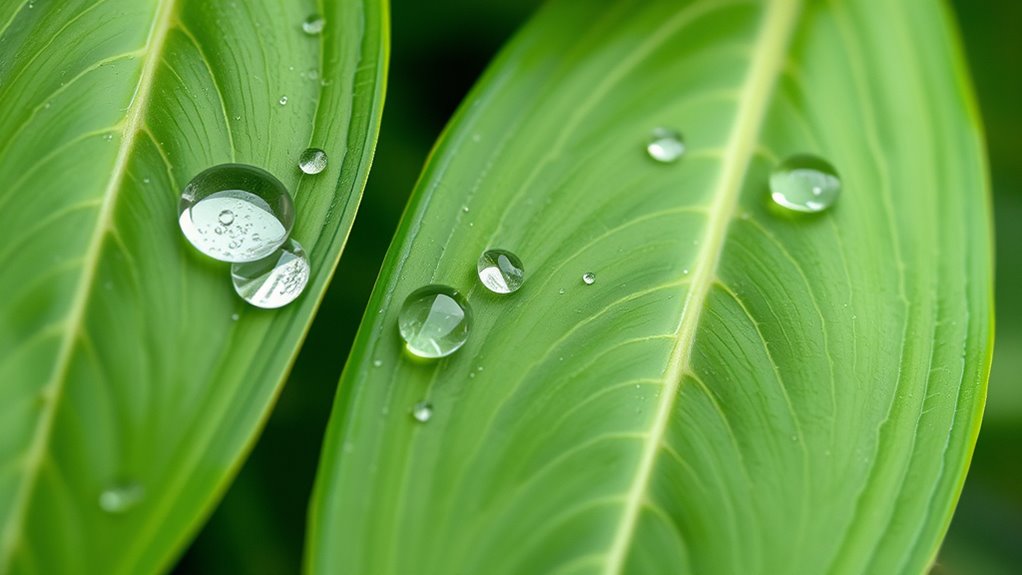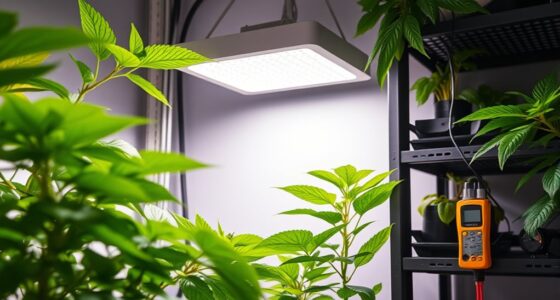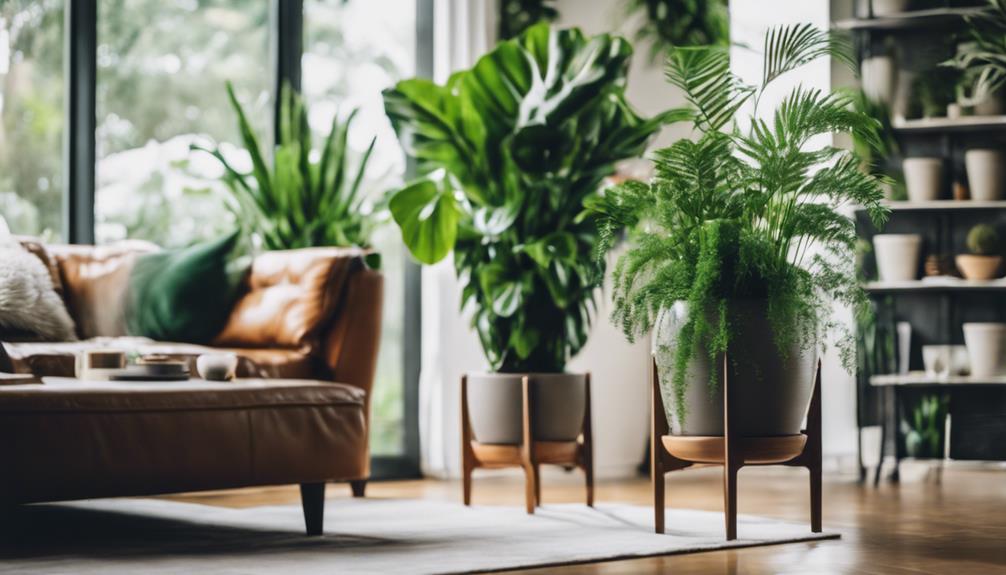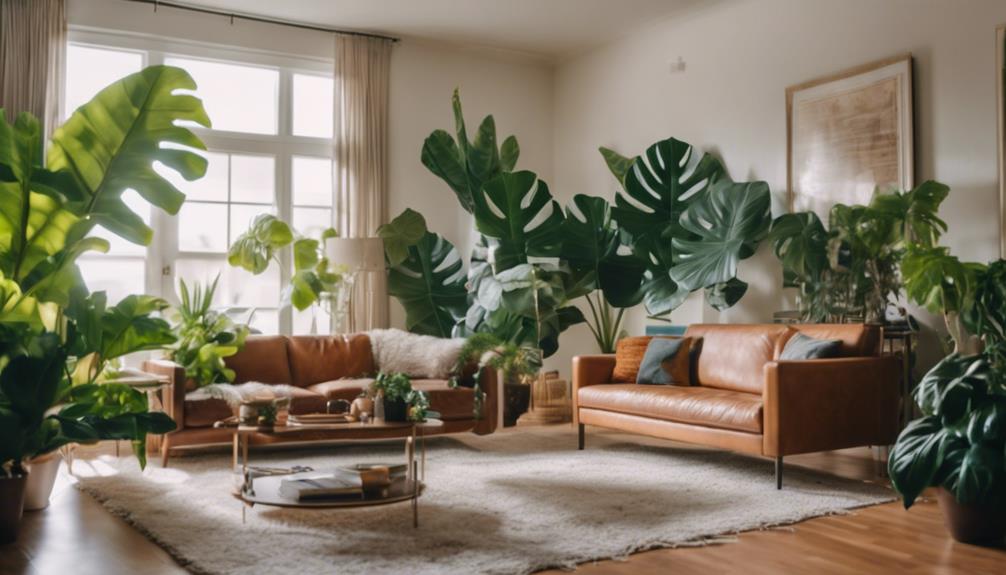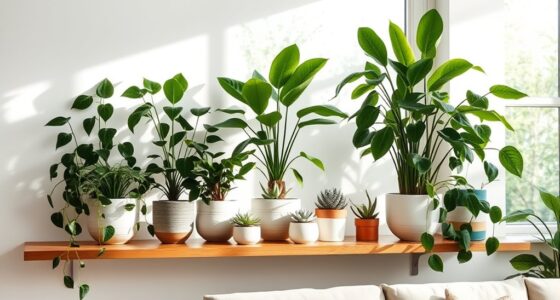To avoid clogging your plant’s pores, apply leaf shine sparingly and follow the manufacturer’s instructions carefully. Use a soft cloth or gentle spray to lightly mist the leaves, ensuring you don’t over-coat them or leave excess buildup. Always start with clean, dust-free leaves and wait until they’re dry before applying. Proper application combined with good plant care helps keep your leaves healthy and vibrant—continue for more tips on safe leaf shine practices.
Key Takeaways
- Do apply leaf shine sparingly and follow manufacturer instructions to prevent excess buildup.
- Do ensure leaves are clean and dry before applying to avoid pore clogging.
- Don’t use thick or overly frequent coats that can block leaf pores and trap debris.
- Do remove dust and debris regularly to maintain pore health and prevent pest issues.
- Don’t rely solely on leaf shine; combine with proper watering and plant hygiene for optimal health.

Using leaf shine products can make your indoor plants look vibrant and healthy, but it’s important to know the right way to apply and maintain them. One key aspect often overlooked is avoiding clogging the plant’s pores, which can hinder essential processes like respiration and transpiration. When applying leaf shine, it’s tempting to use a generous coating to achieve that glossy look, but too much product can settle into the tiny pores on the leaf surface. This can block airflow and trap dust or debris, making your plant more susceptible to pests and diseases. To prevent this, always follow the manufacturer’s instructions carefully—less is often more. Use a soft cloth or a gentle spray, and wipe or mist lightly, ensuring you cover the surface without excess buildup. Incorporating proper watering techniques alongside leaf shine application is also crucial, as overwatering or inconsistent watering can weaken your plants’ defenses, making them more vulnerable to pests. When your plants are stressed or unhealthy, the glossy appearance from leaf shine can sometimes mask underlying issues, leading you to overlook early signs of pests or diseases. Regularly check your plants’ soil moisture levels and adjust watering routines accordingly. Well-hydrated plants are better equipped to fend off pests and maintain healthy pores, which, in turn, helps the leaf shine do its job without clogging or suffocating the plant. It’s equally important to keep the leaves clean by removing dust and debris before applying leaf shine. Dusty leaves can trap more dirt when coated with shine, creating a breeding ground for pests like spider mites or aphids. Clean leaves gently with a damp cloth, then wait until they’re dry before applying any shine product. This minimizes the risk of clogging pores and ensures your plant breathes properly. Remember, pest prevention is a fundamental part of plant care; a clean, healthy plant is less appealing to pests, and a proper leaf shine application can contribute to that by enhancing overall plant health and appearance.
Frequently Asked Questions
Can Leaf Shine Products Harm Your Plant’S Health?
You might wonder if leaf shine products can harm your plant’s health. If you use them improperly, chemical residues can clog pores, blocking essential gas exchange. This can lead to plant stress and hinder growth. To avoid damage, apply leaf shine sparingly and choose products designed specifically for plants. Regularly cleaning leaves with water helps prevent buildup, ensuring your plant remains healthy and vibrant without risking harm.
How Often Should I Apply Leaf Shine?
You should apply leaf shine sparingly, typically once every few weeks, to avoid clogging pores. The ideal timing is when your plant’s leaves look dull or dusty, so you can enhance their appearance without overdoing it. Keep an eye on the application frequency, and always follow the product instructions. Remember, less is more—over-application can harm your plant’s health and block its natural ability to breathe.
Are Natural or DIY Leaf Shines Safer for Plants?
You might wonder if natural or DIY leaf shines are safer for your plants. Generally, DIY alternatives using ingredients like water, olive oil, or diluted dish soap are safer because you control what goes on your plants, reducing the risk of clogging pores. Commercial products can contain chemicals that may harm your plant’s leaves or clog pores if overused. Always test a small area first and avoid excess application to keep your plants healthy.
What Are Signs of Leaf Pore Clogging?
Think of your plant as a lush garden needing clear pathways; pore blockage can turn these pathways into clogged roads. Signs of clogged pores include yellowing leaves, limpness, or spots that won’t heal. You might also notice a dull sheen or sticky residue on the surface. These symptoms threaten leaf health, so monitor closely. If you see these signs, it’s time to adjust your care routine to keep those pores open and your plant thriving.
Can Leaf Shine Cause Leaf Discoloration?
Yes, leaf shine can cause leaf discoloration if used improperly. Overapplication can clog pores, leading to pest attraction and leaf damage. When pores are blocked, leaves can’t breathe or absorb nutrients properly, resulting in yellowing or dullness. To prevent this, use leaf shine sparingly and avoid applying it to dusty or dirty leaves, which can worsen discoloration and attract pests. Proper application helps keep leaves healthy and vibrant.
Conclusion
To keep your plants healthy, avoid clogging their pores by overapplying leaf shine, skip harsh chemicals, and never forget to clean their leaves gently. Embrace natural methods, use the right products, and give your plants proper care. Protect their pores, promote their health, and enhance their beauty. By following these do’s and don’ts, you’ll ensure your plants stay vibrant, glossy, and thriving—because healthy leaves are happy leaves, and happy leaves make a happy home.
